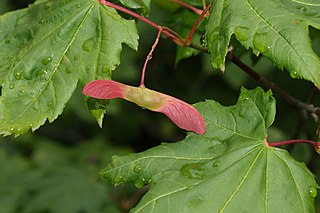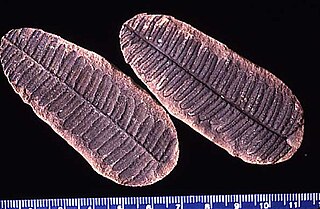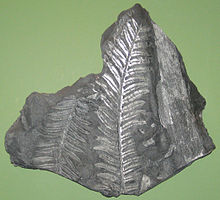
A samara is a winged achene, a type of fruit in which a flattened wing of fibrous, papery tissue develops from the ovary wall. A samara is a simple dry fruit, and is indehiscent. The shape of a samara enables the wind to carry the seed farther away from the tree than regular seeds would go, and is thus a form of anemochory.

The lycophytes, when broadly circumscribed, are a group of vascular plants that include the clubmosses. They are sometimes placed in a division Lycopodiophyta or Lycophyta or in a subdivision Lycopodiophytina. They are one of the oldest lineages of extant (living) vascular plants; the group contains extinct plants that have been dated from the Silurian. Lycophytes were some of the dominating plant species of the Carboniferous period, and included the tree-like Lepidodendrales, some of which grew over 40 metres (130 ft) in height, although extant lycophytes are relatively small plants.
In botany, a section is a taxonomic rank below the genus, but above the species. The subgenus, if present, is higher than the section, and the rank of series, if present, is below the section. Sections may in turn be divided into subsections.

Chadwick Arboretum is a 62 acres (25 ha) arboretum on the Agriculture campus of The Ohio State University, in Columbus, Ohio, United States. The main arboretum collection is located just across Lane Avenue from the Schottenstein Center with its other collections nearby. The arboretum is open daily without charge.

The cladoxylopsids are an extinct group of plants related to ferns and sphenopsids.
Alexander Gordon Penn was a U.S. Representative from Louisiana.

Jubaeopsis caffra, the Pondoland palm, is a flowering plant species in the palm family (Arecaceae). It belongs to the monotypic genus Jubaeopsis.

Polysporangiophytes, also called polysporangiates or formally Polysporangiophyta, are plants in which the spore-bearing generation (sporophyte) has branching stems (axes) that bear sporangia. The name literally means 'many sporangia plant'. The clade includes all land plants (embryophytes) except for the bryophytes whose sporophytes are normally unbranched, even if a few exceptional cases occur. While the definition is independent of the presence of vascular tissue, all living polysporangiophytes also have vascular tissue, i.e., are vascular plants or tracheophytes. Extinct polysporangiophytes are known that have no vascular tissue and so are not tracheophytes.

Pecopteris is a very common form genus of leaves. Most Pecopteris leaves and fronds are associated with the marattialean tree fern Psaronius. However, Pecopteris-type foliage also is borne on several filicalean ferns, and at least one seed fern. Pecopteris first appeared in the Devonian period, but flourished in the Carboniferous, especially the Pennsylvanian. Plants bearing these leaves became extinct in the Permian period, due to swamps disappearing and temperatures on Earth dropping.

The Blackfoot Mountains, also called the Blackfoot Range, is a small range of mountains located east of Blackfoot, Idaho. Most of the area is private property, including the range's tallest mountain, Taylor Mountain. This mountain was named after Sam Taylor, an early settler of Idaho and brother of Matt Taylor. The Blackfoot River carves through the region. Within this range is Wolverine Canyon, a public area that features sites for hiking, camping, kayaking, rock climbing and other recreational pursuits.

Plants are the eukaryotes that form the kingdom Plantae; they are predominantly photosynthetic. This means that they obtain their energy from sunlight, using chloroplasts derived from endosymbiosis with cyanobacteria to produce sugars from carbon dioxide and water, using the green pigment chlorophyll. Exceptions are parasitic plants that have lost the genes for chlorophyll and photosynthesis, and obtain their energy from other plants or fungi.
Lufkin is a brand featuring primarily measurement tools such as calipers, gauges, micrometers, and measuring tapes. Lufkin is a brand of Apex Tool Group.

A seed plant or spermatophyte, also known as a phanerogam or a phaenogam, is any plant that produces seeds. It is a category of embryophyte that includes most of the familiar land plants, including the flowering plants and the gymnosperms, but not ferns, mosses, or algae.

Annales de la Société entomologique de France is one of the oldest entomology journals in the world. It was founded in 1832, and began a new series in 1965, when it merged with Revue Française d'Entomologie and Revue de Pathologie Végétale et d'Entomologie Agricole de France. It is published by Taylor & Francis. It publishes original research papers about insects (Hexapoda), Arachnida and Myriapoda: taxonomy, comparative morphology, phylogeny, zoogeography, population genetics, plant-insect relationships, ethology, ecology, biology. Concerning taxonomy, the journal avoids publishing isolated descriptions and gives preference to papers that include ecological, biogeographical, phylogenetical considerations, or comprehensive revisions.
Nepenthes appendiculata is a tropical pitcher plant known only from the Hose Mountains of central Sarawak, Borneo, where it grows at elevations of 1450–1700 m above sea level. The species is characterised by an enlarged glandular appendage on the lower lid surface, for which it is named.

Pagiophyllum is a form genus of fossil coniferous plant foliage. Plants of the genus have been variously assigned to several different conifer groups including Araucariaceae and Cheirolepidiaceae. They were found around the globe during the Carboniferous to the Cretaceous period.

The Peltaspermales are an extinct order of seed plants, often considered "seed ferns". They span from the Late Carboniferous to the Early Jurassic. It includes at least one valid family, Peltaspermaceae, which spans from the Permian to Early Jurassic, which is typified by a group of plants with Lepidopteris leaves, Antevsia pollen-organs, and Peltaspermum ovulate organs, though the family now also includes other genera like Peltaspermopsis, Meyenopteris and Scytophyllum. Along with these, two informal groups of uncertain taxonomic affinities exist, each centered around a specific genus ; Supaia and Comia, known from the Early Permian of the Northern Hemisphere, especially of North America. Both the "Comioids" and the "Supaioids" are associated with the peltaspermacean ovulate organ Autunia. The Late Triassic-Middle Jurassic genus Pachydermophyllum may also have affinities to the peltasperms.

Taylor is an extinct town in King County, in the U.S. state of Washington.
Sweethearts of the U.S.A. is a 1944 American musical comedy film directed by Lewis D. Collins and starring Una Merkel, Harry Parke, and Donald Novis. In Britain, it was released under the alternative title of Sweethearts on Parade.
The barinophytes are a group of extinct vascular plants (tracheophytes). Their relationship with other vascular plants is unclear. They have been treated as the separate class Barinophytopsida, the order Barinophytales of uncertain class and as a family or clade Barinophytaceae within the zosterophylls. They have also been considered to be possible lycopodiopsids.














